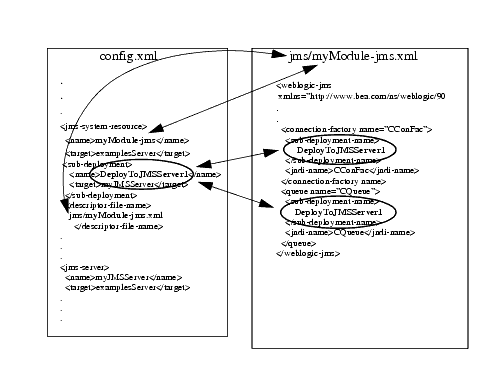







|
The WebLogic Scripting Tool (WLST) is a command-line scripting interface that you can use to create and manage JMS servers and JMS system module resources. See Using the WebLogic Scripting Tool and WLST Sample Scripts in WebLogic Scripting Tool.
A JMS system module is described by the jms-system-resource MBean in the config.xml file. Basic components of a jms-system-resource MBean are:
name—Name of the module.target—Server, cluster, or migratable target the module is targeted to.sub-deployment—A mechanism by which JMS system module resources (such as queues, topics, and connection factories) are grouped and targeted to a server resource (such as a JMS server instance, WebLogic server instance, or cluster). descriptor-file-name—Path and filename of the system module file.
The JMS resources of a system module are located in a module descriptor file that conforms to the weblogic-jmsmd.xml schema. In Figure 6-1, the module is named myModule-jms.xml and it contains JMS system resource definitions for a connection factory and a queue. The sub-deployment-name element is used to group and target JMS resources in the myModule-jms.xml file to targets in the config.xml. You have to provide a value for the sub-deployment-name element when using WLST. For more information on subdeployments, see
JMS System Module and Resource Subdeployment Targeting in Configuring and Managing WebLogic JMS. In Figure 6-1, the sub-deployment-name DeployToJMSServer1is used to group and target the connection factory CConfac and the queue CQueue in the myModule-jms module.
For more information on how to use JMS resources, see Understanding JMS Resource Configuration in Configuring and Managing WebLogic JMS.

Basic tasks you need to perform when creating JMS system resources with WLST are:
After you have established an edit session, use the following steps configure JMS servers and system module resources:
servermb=getMBean("Servers/examplesServer")
if servermb is None:
print '@@@ No server MBean found'jmsMySystemResource = create(myJmsSystemResource,"JMSSystemResource")
jmsMySystemResource.addTarget(servermb)
theJMSResource = jmsMySystemResource.getJMSResource()
connfact1 = theJMSResource.createConnectionFactory(factoryName)
jmsqueue1 = theJMSResource.createQueue(queueName)
connfact1.setJNDIName(factoryName)
jmsqueue1.setJNDIName(queueName)
connfact1.setSubDeploymentName('DeployToJMSServer1')
jmsqueue1.setSubDeploymentName('DeployToJMSServer1')jmsserver1mb = create(jmsServerName,'JMSServer')
jmsserver1mb.addTarget(servermb)
sub-deployment-name element. This step groups the system resources in module to a sub-deployment element in the config.xml. For example:subDep1mb = jmsMySystemResource.createSubDeployment('DeployToJMSServer1')subDep1mb.addTarget(jmsserver1mb)
"""
This script starts an edit session, creates a JMS Server,
targets the jms server to the server WLST is connected to and creates
a JMS System module with a jms queue and connection factory. The
jms queues and topics are targeted using sub-deployments.
"""
import sys
from java.lang import System
print "@@@ Starting the script ..."
myJmsSystemResource = "CapiQueue-jms"
factoryName = "CConFac"
jmsServerName = "myJMSServer"
queueName = "CQueue"
url = sys.argv[1]
usr = sys.argv[2]
password = sys.argv[3]
connect(usr,password, url)
edit()
startEdit()
//Step 1
servermb=getMBean("Servers/examplesServer")
if servermb is None:
print '@@@ No server MBean found'
else:
//Step 2
jmsMySystemResource = create(myJmsSystemResource,"JMSSystemResource")
//Step 3
jmsMySystemResource.addTarget(servermb)
//Step 4
theJMSResource = jmsMySystemResource.getJMSResource()
//Step 5
connfact1 = theJMSResource.createConnectionFactory(factoryName)
jmsqueue1 = theJMSResource.createQueue(queueName)
//Step 6
connfact1.setJNDIName(factoryName)
jmsqueue1.setJNDIName(queueName)
//Step 7
jmsqueue1.setSubDeploymentName('DeployToJMSServer1')
connfact1.setSubDeploymentName('DeployToJMSServer1')
//Step 8
jmsserver1mb = create(jmsServerName,'JMSServer')
//Step 9
jmsserver1mb.addTarget(servermb)
//Step 10
subDep1mb = jmsMySystemResource.createSubDeployment('DeployToJMSServer1')//Step 11
subDep1mb.addTarget(jmsserver1mb)
.
.
.
You can modify or monitor JMS objects and attributes by using the appropriate method available from the MBean.
For more information, see Navigating MBeans (WLST Online) in the WebLogic Scripting Tool.
.
.
print '@@@ delete system resource'
jmsMySystemResource = delete("CapiQueue-jms","JMSSystemResource")
print '@@@ delete server'
jmsserver1mb = delete(jmsServerName,'JMSServer')
.
.
.
This section provides best practices information when using WLST to configure JMS servers and JMS system module resources:


|